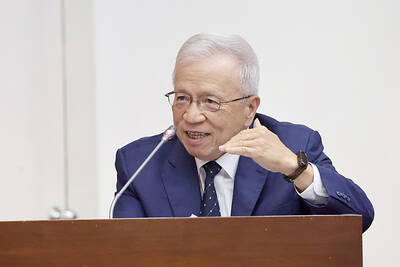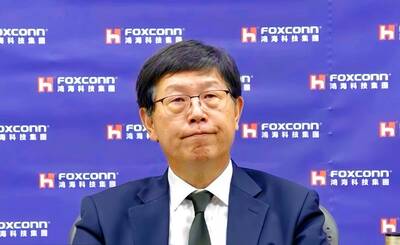Taiwan Semiconductor Manufacturing Co (TSMC, 台積電) yesterday reported record-high revenue again for last month, reflecting continued strong demand for its advanced 28-nanometer chips mainly used for mobile devices.
The world’s top contract chipmaker saw revenue last month grow 11.7 percent to NT$48.53 billion (US$1.62 billion) from June’s NT$43.43 billion, TSMC said in a statement. That was a 37 percent expansion from NT$35.43 billion in July last year.
Last month’s revenue beat Credit Suisse’s forecast of NT$45.2 billion, but the foreign broker expects TSMC to see slower growth this month and next.
“We believe the growth momentum should slow in August and September as utilization begins to slow” because of an inventory correction in the second half, Credit Suisse analyst Randy Abrams said in a report issued yesterday.
A monthly decrease of 5 to 6 percent this month and next would still allow TSMC to reach the higher end of its forecast range of NT$138 billion for the current quarter.
On July 19, TSMC forecast revenue would hit a new record this quarter by increasing between 6 percent and 8 percent sequentially to between NT$136 billion and NT$138 billion, compared with NT$128.06 billion in the second quarter.
“We expect a very good third quarter,” TSMC chairman and CEO Morris Chang (張忠謀) told investors at the time.
Abrams said in the report that he believed demand for TSMC’s 28nm chips remained tight because of capacity constraints, while demand for 40nm capacity would remain full thanks to low-cost smartphone chip orders from MediaTek Inc (聯發科), the nation’s biggest handset chip supplier.
TSMC said last month that it expected third-quarter shipments of 28nm chips would double sequentially, as output and yields have surpassed the targets it set in January.
The company said it would ramp up the production of 28nm chips to 68,000 12-inch wafers a month, helping it catch up with customers’ demand and boost revenue contribution from 28nm chips to 20 percent by the end of the year, from 5 percent last quarter.
TSMC supplies 28nm chips to US chipmakers Qualcomm Inc and Nvidia Inc.
Abrams retained his “outperform” rating on TSMC with target price at NT$95, implying an upside of 15.85 percent from its closing price of NT$82 yesterday.
Separately, MStar Semiconductor Inc (晨星半導體), the world’s biggest supplier of chips used in LCD TVs, yesterday said revenue edged up 0.4 percent to NT$2.92 billion, compared with NT$2.907 billion in June. On an annual basis, that was an increase of 8.6 percent from NT$2.69 billion.
MStar, which MediaTek said on June 22 it would acquire in a NT$115 billion deal, said on Thursday that MediaTek had bought 282 million of its shares, exceeding a minimum 40 percent, or 212 million shares, acquisition requirement.
MediaTek is scheduled to complete the transaction early next year, which has gained approval by Taiwan’s regulators, including the Fair Trade Commission, the Financial Supervisory Commission and the Ministry of Economic Affairs.

JITTERS: Nexperia has a 20 percent market share for chips powering simpler features such as window controls, and changing supply chains could take years European carmakers are looking into ways to scratch components made with parts from China, spooked by deepening geopolitical spats playing out through chipmaker Nexperia BV and Beijing’s export controls on rare earths. To protect operations from trade ructions, several automakers are pushing major suppliers to find permanent alternatives to Chinese semiconductors, people familiar with the matter said. The industry is considering broader changes to its supply chain to adapt to shifting geopolitics, Europe’s main suppliers lobby CLEPA head Matthias Zink said. “We had some indications already — questions like: ‘How can you supply me without this dependency on China?’” Zink, who also

At least US$50 million for the freedom of an Emirati sheikh: That is the king’s ransom paid two weeks ago to militants linked to al-Qaeda who are pushing to topple the Malian government and impose Islamic law. Alongside a crippling fuel blockade, the Group for the Support of Islam and Muslims (JNIM) has made kidnapping wealthy foreigners for a ransom a pillar of its strategy of “economic jihad.” Its goal: Oust the junta, which has struggled to contain Mali’s decade-long insurgency since taking power following back-to-back coups in 2020 and 2021, by scaring away investors and paralyzing the west African country’s economy.

BUST FEARS: While a KMT legislator asked if an AI bubble could affect Taiwan, the DGBAS minister said the sector appears on track to continue growing The local property market has cooled down moderately following a series of credit control measures designed to contain speculation, the central bank said yesterday, while remaining tight-lipped about potential rule relaxations. Lawmakers in a meeting of the legislature’s Finance Committee voiced concerns to central bank officials that the credit control measures have adversely affected the government’s tax income and small and medium-sized property developers, with limited positive effects. Housing prices have been climbing since 2016, even when the central bank imposed its first set of control measures in 2020, Chinese Nationalist Party (KMT) Legislator Lo Ting-wei (羅廷瑋) said. “Since the second half of

AI BOOST: Next year, the cloud and networking product business is expected to remain a key revenue pillar for the company, Hon Hai chairman Young Liu said Manufacturing giant Hon Hai Precision Industry Co (鴻海精密) yesterday posted its best third-quarter profit in the company’s history, backed by strong demand for artificial intelligence (AI) servers. Net profit expanded 17 percent annually to NT$57.67 billion (US$1.86 billion) from NT$44.36 billion, the company said. On a quarterly basis, net profit soared 30 percent from NT$44.36 billion, it said. Hon Hai, which is Apple Inc’s primary iPhone assembler and makes servers powered by Nvidia Corp’s AI accelerators, said earnings per share expanded to NT$4.15 from NT$3.55 a year earlier and NT$3.19 in the second quarter. Gross margin improved to 6.35 percent,